The effect of forward sweep in a transonic - MTU Aero Engines
The effect of forward sweep in a transonic - MTU Aero Engines
The effect of forward sweep in a transonic - MTU Aero Engines
You also want an ePaper? Increase the reach of your titles
YUMPU automatically turns print PDFs into web optimized ePapers that Google loves.
THE EFFECT OF FORWARD SWEEP<br />
IN A TRANSONIC COMPRESSOR ROTOR<br />
Harald PASSRUCKER Mart<strong>in</strong> ENGBER<br />
<strong>MTU</strong> <strong>Aero</strong> Eng<strong>in</strong>es, Dachauer Straße 665, 80995 München / Germany<br />
Harald.Passrucker@muc.mtu.de Mart<strong>in</strong>.Engber@muc.mtu.de<br />
Stephan KABLITZ Dietmar K. HENNECKE<br />
Darmstadt University <strong>of</strong> Technology, Gas Turb<strong>in</strong>es and Flight Propulsion,<br />
Darmstadt / Germany<br />
kablitz@gfa.tu-darmstadt.de hennecke@gfa.tu-darmstadt.de<br />
ABSTRACT<br />
This paper presents design and test<strong>in</strong>g <strong>of</strong> a <strong>transonic</strong> compressor rotor with<br />
<strong>forward</strong> <strong>sweep</strong>. <strong>The</strong> rotor was used to <strong>in</strong>vestigate the <strong>in</strong>fluence <strong>of</strong> <strong>forward</strong> <strong>sweep</strong> on<br />
performance and stability <strong>of</strong> a s<strong>in</strong>gle stage <strong>transonic</strong> compressor compared with a<br />
basel<strong>in</strong>e design with radially stacked blade sections. <strong>The</strong> comparison was done<br />
numerically with the 3D Navier-Stokes code TRACE_S and experimentally <strong>in</strong> the<br />
Darmstadt Transonic Compressor test rig. It was found that the new rotor with <strong>forward</strong><br />
<strong>sweep</strong> has an <strong>in</strong>creased efficiency and also a much better stall marg<strong>in</strong> (much more <strong>in</strong> the<br />
rig test than predicted by the 3D Navier-Stokes calculation). Particularly close to stall<br />
the <strong>forward</strong> <strong>sweep</strong> diverts the flow towards the blade tip region which helps to stabilise<br />
this region. For that reason it is possible to throttle the <strong>forward</strong> swept rotor much<br />
further as the radially stacked rotor although the <strong>forward</strong>-swept rotor does already<br />
suffer from separated flow <strong>in</strong> the hub.<br />
INTRODUCTION<br />
A major part <strong>of</strong> the losses <strong>in</strong> <strong>transonic</strong> compressor rotors is created near the blade tip.<br />
Shock losses and the <strong>in</strong>teraction <strong>of</strong> the shock with other flow phenomena, like tip clearance<br />
flow or boundary layers, also contribute to these losses. <strong>The</strong> tendency <strong>of</strong> the shock to cause<br />
boundary layer separation can account for an amount <strong>of</strong> loss which is significantly higher than<br />
the actual shock loss. <strong>The</strong>refore, <strong>sweep</strong> has been considered as a method to reduce shock<br />
strength and to improve efficiency and surge marg<strong>in</strong>. Denton et al. [1] analysed by CFD that<br />
the <strong>effect</strong> <strong>of</strong> <strong>sweep</strong> and lean on <strong>transonic</strong> fan efficiency and pressure ratio is remarkably<br />
small, but have a significant <strong>in</strong>fluence on the stall po<strong>in</strong>t <strong>of</strong> the fan. Ulrich [2] numerically<br />
<strong>in</strong>vestigated the <strong>in</strong>fluence <strong>of</strong> <strong>sweep</strong> and lean on a <strong>transonic</strong> rotor with the same result. <strong>The</strong>re<br />
are ma<strong>in</strong>ly 3 physical <strong>effect</strong>s how <strong>sweep</strong> does <strong>in</strong>fluence the flow <strong>in</strong> a blade row.<br />
Basic <strong>effect</strong>s <strong>of</strong> swept blades on compressor flow<br />
a) Influence <strong>of</strong> the blade load<strong>in</strong>g (figure 1): <strong>The</strong> pressure gradient perpendicular to a<br />
plane end wall must be zero, s<strong>in</strong>ce there can be no acceleration perpendicular to the wall. In<br />
the case <strong>of</strong> figure 1 (aft <strong>sweep</strong>), the blade load<strong>in</strong>g near the lower wall must be reduced near<br />
the lead<strong>in</strong>g edge where the load<strong>in</strong>g rapidly falls to zero (no blade) as one moves<br />
perpendicularly away from the wall. Conversely the load<strong>in</strong>g on the lower wall will tend to be<br />
<strong>in</strong>creased near the trail<strong>in</strong>g edge s<strong>in</strong>ce there can be little pressure difference between it and the<br />
more highly loaded region above it. <strong>The</strong> opposite <strong>effect</strong> occurs near the upper wall. Generally<br />
the load<strong>in</strong>g <strong>in</strong> the tip region is reduced <strong>in</strong> the front area with the <strong>forward</strong>-<strong>sweep</strong> which results
<strong>in</strong> a lead<strong>in</strong>g edge which is more tolerant to changes <strong>in</strong> <strong>in</strong>cidence. Furthermore the tip leakage<br />
is reduced <strong>in</strong> this area (lower load<strong>in</strong>g).<br />
b) Influence on the shock position (figure 2): In the spanwise direction, the shock cannot<br />
<strong>in</strong>tersect the outer cas<strong>in</strong>g obliquely. It must either turn normal to the cas<strong>in</strong>g or possibly<br />
bifurcate <strong>in</strong> a shock/boundary-layer <strong>in</strong>tersection. This requirement on the spanwise shock<br />
shape near the cas<strong>in</strong>g is an <strong>in</strong>viscid phenomenon. In the absence <strong>of</strong> an endwall, the shock<br />
shapes for the <strong>forward</strong>- and aft-swept rotors would be bent <strong>forward</strong> or backward <strong>in</strong> similar<br />
fashion. In the presence <strong>of</strong> the endwall, however, the shock must turn normal to the cas<strong>in</strong>g,<br />
mov<strong>in</strong>g upstream for an aft-swept rotor and downstream for the <strong>forward</strong>-swept rotor.<br />
Generally, a shock position which is further downstream <strong>in</strong> the tip region, leads to a better<br />
stall marg<strong>in</strong> because the rotor can be throttled further until the bow shock detaches from the<br />
lead<strong>in</strong>g edge.<br />
c) Influence on the accumulation <strong>of</strong> low momentum fluid near the endwall (figure 3): In<br />
a conventional rotor, fluid particles <strong>in</strong>side the blade boundary layer move radially outward<br />
due to the imbalance between the centrifugal forces and the pressure gradient. <strong>The</strong><br />
accumulation <strong>of</strong> low momentum fluid near the endwall is considered to be a major cause <strong>of</strong><br />
<strong>in</strong>creased aerodynamic loss and reduced operation range. In the case <strong>of</strong> a <strong>forward</strong>-swept rotor,<br />
two mechanisms lessen the accumulation <strong>of</strong> low momentum fluid near the endwall. First, the<br />
radially migrat<strong>in</strong>g boundary layer flow cannot reach the endwall region due to the <strong>forward</strong><br />
<strong>sweep</strong> <strong>of</strong> the blade. Second, the region <strong>of</strong> high pressure on the suction surface after the peak<br />
<strong>in</strong> the pressure distribution is located further upstream at the tip region than at the hub region.<br />
<strong>The</strong>refore, radial migration <strong>of</strong> the low momentum fluid is suppressed and accumulation <strong>of</strong><br />
low momentum fluid near the tip is reduced.<br />
Figure 1: Effect <strong>of</strong> <strong>sweep</strong> on blade load<strong>in</strong>g<br />
(Denton [3])<br />
Figure 2: Endwall <strong>effect</strong> on shock structure<br />
near the cas<strong>in</strong>g (Hah et al. [4])<br />
Figure 3: Secondary flow <strong>in</strong> a <strong>forward</strong> swept rotor (Yamaguchi et al. [5])<br />
History <strong>of</strong> different swept Rotors tested at TU-Darmstadt<br />
<strong>The</strong> Darmstadt Transonic Compressor test rig was brought <strong>in</strong>to operation <strong>in</strong> close cooperation<br />
with <strong>MTU</strong> <strong>Aero</strong> Eng<strong>in</strong>es Munich <strong>in</strong> 1993. A series <strong>of</strong> 3 rotors was used to<br />
<strong>in</strong>vestigate the <strong>in</strong>fluence <strong>of</strong> <strong>sweep</strong> and lean on performance and stability <strong>of</strong> a s<strong>in</strong>gle stage<br />
<strong>transonic</strong> compressor. <strong>The</strong> basel<strong>in</strong>e Rotor No.1 (Rotor 1) with radially stacked blade sections
was designed by Schulze et al. [6]. To <strong>in</strong>vestigate the <strong>in</strong>fluence <strong>of</strong> blade <strong>sweep</strong>, especially <strong>in</strong><br />
the tip region, a Rotor No.2 (Rotor 2) was designed with considerable aft-<strong>sweep</strong>. It was<br />
<strong>in</strong>vestigated <strong>in</strong> 2000 (Blaha et al. [7]). Rotor No.3 (Rotor 3) features <strong>forward</strong> <strong>sweep</strong> and was<br />
tested <strong>in</strong> 2001.<br />
TEST FACILITY AND MEASUREMENT EQUIPMENT<br />
This section briefly describes the test rig (figure 4, 5) and conventional <strong>in</strong>strumentation<br />
used to determ<strong>in</strong>e speedl<strong>in</strong>es and efficiency.<br />
Figure 4: Sketch <strong>of</strong> the test facility Figure 5: Cross section <strong>of</strong> the test compressor<br />
Inlet total pressure and temperature are taken <strong>in</strong> the settl<strong>in</strong>g chamber <strong>in</strong> front <strong>of</strong> a<br />
bellmouth. At the <strong>in</strong>let, wall static pressure is measured to determ<strong>in</strong>e the mass flow by us<strong>in</strong>g a<br />
calibrated nozzle. Pressure losses <strong>in</strong> the <strong>in</strong>let duct are taken <strong>in</strong>to account by an experimentally<br />
determ<strong>in</strong>ed loss coefficient. <strong>The</strong> downstream flow conditions are taken from fixed total<br />
pressure and total temperature probe rakes located on the bear<strong>in</strong>g support struts beh<strong>in</strong>d the<br />
stator (figure 6), while the stator is traversed circumferentially. Shaft speed, power and torque<br />
are measured by a Torquemeter measur<strong>in</strong>g device between the 800kW DC-drive and the<br />
compressor.<br />
Figure 6: Total pressure and total temperature probe rakes<br />
Measurements <strong>of</strong> speedl<strong>in</strong>es were performed by recently upgraded Pitot type total<br />
pressure and total temperature rakes mounted on the five struts downstream <strong>of</strong> the stator.<br />
Complement<strong>in</strong>g the eleven pitot type total pressure probes two static pressure taps are located<br />
at the same axial position to gather static pressure <strong>in</strong>formation at hub and cas<strong>in</strong>g. By<br />
travers<strong>in</strong>g the stator upstream <strong>of</strong> the rakes <strong>in</strong> <strong>in</strong>crements <strong>of</strong> 5% stator pitch, the stator exit
plane is resolved with 20 positions pitchwise and 13 probe locations from hub to tip, yield<strong>in</strong>g<br />
260 s<strong>in</strong>gle pressure values. For determ<strong>in</strong>ation <strong>of</strong> the total pressure ratio the data is at first<br />
averaged circumferentially, us<strong>in</strong>g an arithmetic average (s<strong>in</strong>ce measur<strong>in</strong>g the whole<br />
temperature distribution required for the massflow weighed average would take way too much<br />
time). For averag<strong>in</strong>g <strong>in</strong> the radial direction, the pressures are weighted accord<strong>in</strong>g to local<br />
massflow us<strong>in</strong>g the measured radial distribution <strong>of</strong> total temperature between two stator<br />
wakes. Isentropic efficiency is calculated by compar<strong>in</strong>g compressor work <strong>in</strong>put to the flow<br />
taken from pressure measurements with work <strong>in</strong>put at the shaft which is measured with the<br />
Torquemeter device <strong>of</strong> the test facility. Total temperature measurements at stator exit give<br />
good general <strong>in</strong>formation about radial distributions <strong>of</strong> efficiency but quantitatively precise<br />
averaged results are too difficult to obta<strong>in</strong> due to the rather long duration <strong>of</strong> temperature<br />
measurements and become even less reliable at part speed conditions. <strong>The</strong> data aquisition<br />
takes 4 m<strong>in</strong>utes for each operat<strong>in</strong>g po<strong>in</strong>t. For a 95% confidence level (U95) at 100% speed<br />
and peak efficiency operat<strong>in</strong>g po<strong>in</strong>t this yields:<br />
• mass flow rate +/- 1.1%<br />
• pressure ratio +/- 0.5 %<br />
• isentropic efficiency +/- 1.4 %<br />
GEOMETRIC DESIGN OF ROTOR 3<br />
Figure 7 shows both rotors. Rotor 1 was designed conventionally with blade pr<strong>of</strong>iles<br />
stacked radially along their centres <strong>of</strong> gravity. Rotor 3’s design features are lower blade<br />
number, pronounced <strong>forward</strong>-<strong>sweep</strong> and higher blade chord length <strong>in</strong> the tip region to reach a<br />
better stability and efficiency.<br />
Rotor 1 (radially stacked) Rotor 3 (<strong>forward</strong>-swept)<br />
Figure 7<br />
<strong>The</strong> blade number <strong>of</strong> Rotor 3 was reduced compared to Rotor 1 from 16 blades to 14<br />
blades. For this reason the solidity <strong>of</strong> Rotor 3 is generally lower than <strong>of</strong> Rotor 1 (figure 9).<br />
<strong>The</strong> blade chord length <strong>of</strong> Rotor 3 was <strong>in</strong>creased <strong>in</strong> the tip region (figure 9) which <strong>in</strong>creases<br />
the solidity there and improves stability and efficiency. <strong>The</strong> <strong>in</strong>let and exit metal angles (figure<br />
10) are more or less the same for both rotors to deliver the same work. Figure 11 shows the<br />
stagger l<strong>in</strong>e <strong>of</strong> Rotor 3 pr<strong>of</strong>iles (centre <strong>of</strong> gravity) <strong>in</strong> axial direction. <strong>The</strong> light-grey curves<br />
illustrate the displacement to <strong>in</strong>droduce the <strong>forward</strong> <strong>sweep</strong>. A small lean (grey curve) was<br />
required <strong>in</strong> the tip region to balance the mechanical stress <strong>in</strong> this area. <strong>The</strong> black curve is the
actual stagg<strong>in</strong>g l<strong>in</strong>e, the sum <strong>of</strong> both displacements. <strong>The</strong> <strong>sweep</strong> displacement is counted <strong>in</strong><br />
direction <strong>of</strong> the blade chord, the lean displacement perpendicular to the chord. <strong>The</strong> <strong>sweep</strong><br />
stagg<strong>in</strong>g l<strong>in</strong>e with the backward displacement <strong>in</strong> the middle was designed <strong>in</strong> a manner to<br />
lower the stress <strong>in</strong> the lead<strong>in</strong>g edge. This is important for FOD (foreign object damage) cases.<br />
chord length L [m]<br />
0.005<br />
0.0 0.2 0.4 0.6 0.8 1.0<br />
relativ height X/H [-]<br />
ROTOR 1<br />
ROTOR 3<br />
Figure 8: Chord length<br />
metal angle [°]<br />
exit angle<br />
L/T [-]<br />
ROTOR 1<br />
ROTOR 3<br />
0.0 0.2 0.4 0.6 0.8 1.0<br />
relativ height X/H [-]<br />
Figure 9: Solidity<br />
0.0 0.1 0.2 0.3 0.4 0.5 0.6 0.7 0.8 0.9 1.0<br />
radius [m]<br />
0.200<br />
0.190<br />
0.180<br />
0.170<br />
0.160<br />
0.150<br />
0.140<br />
0.130<br />
0.120<br />
0.110<br />
0.100<br />
<strong>in</strong>let angle<br />
relativ height X/H [-]<br />
blade chord angle<br />
Figure 10: Blade metal angles<br />
<strong>sweep</strong><br />
lean<br />
both<br />
axial displacement<br />
Figure 11: Pr<strong>of</strong>iles stagger l<strong>in</strong>e Rotor 3<br />
5<br />
ROTOR 1<br />
ROTOR 3<br />
0.1
COMPUTATIONAL GRID AND BOUNDARY CONDITION S<br />
<strong>The</strong> simulation was performed with the steady 3D Navier-Stokes-Solver TRACE_S<br />
(details are found <strong>in</strong> Fritsch et al. [8]) on a relative f<strong>in</strong>e H/O-grid (figure 12) with a H-grid <strong>in</strong><br />
the rotor tip gap (0.9mm) (Rotor H(105×33×65), O(129×9×65), Hgap(129×5×9); Stator<br />
H(105×33×65), O(129×9×65)) for both rotors. <strong>The</strong> k-ε model was uses for turbulence<br />
modell<strong>in</strong>g with wall function. Design speed is 20,000 rpm. At the <strong>in</strong>let total temperature, total<br />
pressure and flow angles are forced. <strong>The</strong> strong gradient <strong>of</strong> the total pressure at the cas<strong>in</strong>g<br />
boundary layer was accounted for by an appropriate boundary condition for that region.<br />
Information between rotor and stator doma<strong>in</strong> is transferred with a mix<strong>in</strong>g plane <strong>in</strong>terface. At<br />
the stator outlet the average pressure with radial equilibrium was set.<br />
Figure 12: Computational grid (Rotor 3)<br />
3D-ANALYSIS AND TEST RESULTS<br />
<strong>The</strong>re is good overall agreement between calculation and measurement (see figure 13,<br />
15). Surge marg<strong>in</strong> <strong>of</strong> Rotor 3 is fortunately much better <strong>in</strong> the measurement. <strong>The</strong> reason is<br />
that the numerical stability is determ<strong>in</strong>ed by the stator tip region <strong>of</strong> where separation occurs.<br />
In the experiment this is no trigger for rotat<strong>in</strong>g stall. <strong>The</strong>refore <strong>in</strong> reality there is separation <strong>in</strong><br />
the stator but no rotat<strong>in</strong>g stall at this operation po<strong>in</strong>t and the compressor can be throttled<br />
further. This is also shown <strong>in</strong> the compressor maps (figure 13, 14). <strong>The</strong> speed l<strong>in</strong>e <strong>of</strong> the rotor<br />
alone is still ris<strong>in</strong>g and delivers more pressure rise, whereas the stage’s speed l<strong>in</strong>e turns<br />
horizontally with no further pressure rise.<br />
With Rotor 3 it was possible to <strong>in</strong>crease the peak efficiency (Navier-Stokes 1.5%,<br />
measurement 1.5%) with the above described features (reduced blade number, <strong>in</strong>creased blade<br />
chord length <strong>in</strong> tip region, <strong>forward</strong> <strong>sweep</strong>). <strong>The</strong> blade number reduction reduces the blockage<br />
and therefore the choke marg<strong>in</strong> moves to higher massflow with a wider operat<strong>in</strong>g range.<br />
Furthermore there is a much higher stability at the throttled condition. Unfortunately it is not<br />
possible to allocate the efficiency pr<strong>of</strong>it and the higher stability to each design change, but<br />
numerical experiments show that the efficiency pr<strong>of</strong>it can be accounted to equal parts to<br />
<strong>in</strong>creased blade chord length, <strong>forward</strong> <strong>sweep</strong> and slight pr<strong>of</strong>ile adoptions. <strong>The</strong> higher stability<br />
is attributed ma<strong>in</strong>ly to the <strong>forward</strong> <strong>sweep</strong>.<br />
Figure 16 shows the measured compressor map for both rotors. Rotor 3 was measured<br />
from 100% down to 30% speed, Rotor 1 only from 100% to 80% speed. Rotor 3 has nearly<br />
constant peak efficiency from 80% to 100% speed, which covers the most operat<strong>in</strong>g po<strong>in</strong>ts <strong>in</strong><br />
an eng<strong>in</strong>e application. Rotor 1 has its peak efficiency at 80% speed and is about 0.4% better<br />
than Rotor 3. <strong>The</strong> difference to 100% speed <strong>in</strong> efficiency is 2.1%. <strong>The</strong> stability at all speed<br />
l<strong>in</strong>es <strong>of</strong> Rotor 1 is significantly lower than Rotor 3. <strong>The</strong> last stable po<strong>in</strong>t at 90 % speed <strong>of</strong><br />
Rotor 3 has been taken <strong>in</strong> the experiment, although there is a strong “negative” pressure rise.<br />
Rotor 3 obviously suffers from strong separation <strong>in</strong> the hub region and produces a lot <strong>of</strong><br />
losses. But <strong>in</strong> the tip region the rotor is still stable and rotat<strong>in</strong>g stall can not yet be detected.
total pressure ratio [-]<br />
total pressure ratio [-]<br />
1.85<br />
1.80<br />
1.75<br />
1.70<br />
1.65<br />
1.60<br />
1.55<br />
1.50<br />
1.45<br />
1.40<br />
1.35<br />
Figure 13: Stage compressor map<br />
1.85<br />
1.80<br />
1.75<br />
1.70<br />
1.65<br />
1.60<br />
1.55<br />
1.50<br />
1.45<br />
1.40<br />
1.35<br />
100%<br />
100%<br />
STAGE (Navier-Stokes)<br />
ROTOR 1<br />
ROTOR 3<br />
1.30<br />
14 14.5 15 15.5 16 16.5 17<br />
STAGE (measurement)<br />
ROTOR 1<br />
ROTOR 3<br />
massflow [kg/sec]<br />
1.30<br />
12.5 13 13.5 14 14.5 15 15.5 16 16.5 17<br />
Δη=2.5<br />
massflow [kg/sec]<br />
Δη=2.5<br />
Figure 15: Stage compressor map<br />
isentrop efficiency[%]<br />
isentrop efficiency[%]<br />
total pressure ratio [-]<br />
total pressure ratio [-]<br />
1.85<br />
1.80<br />
1.75<br />
1.70<br />
1.65<br />
1.60<br />
1.55<br />
1.50<br />
1.45<br />
1.40<br />
1.35<br />
100%<br />
ROTOR (Navier-Stokes)<br />
ROTOR 1<br />
ROTOR 3<br />
1.30<br />
14 14.5 15 15.5 16 16.5 17<br />
2.00<br />
1.90<br />
1.80<br />
1.70<br />
1.60<br />
1.50<br />
1.40<br />
1.30<br />
1.20<br />
1.10<br />
massflow [kg/sec]<br />
Figure 14: Rotor compressor map<br />
30%<br />
40%<br />
=5<br />
STAGE (measurement)<br />
50%<br />
65%<br />
80%<br />
90%<br />
100%<br />
1.00<br />
2 4 6 8 10 12 14 16 18<br />
massflow [kg/sec]<br />
Δη=2.5<br />
ROTOR 1<br />
ROTOR 3<br />
Figure 16: Stage compressor map<br />
isentrop efficiency[%]<br />
isentrop efficiency[%]
Figure 17 illustrates radial distributions <strong>of</strong> stage total pressure ratio and isentropic<br />
efficiency near choke (m=16.7), peak efficiency (m=16.4), near stall (m=12.6) and one po<strong>in</strong>t<br />
<strong>in</strong> between (m=15.2). Remarkable is the near stall radial distribution, where the rotor still<br />
delivers high pressure rise <strong>in</strong> the tip region which <strong>in</strong>dicates high stability. In the mid there is a<br />
little penetration <strong>in</strong> pressure rise. <strong>The</strong> other curves seem to be consistent with a cont<strong>in</strong>uous<br />
pressure rise at different throttle conditions. <strong>The</strong> highest efficiency is as expected <strong>in</strong> the mid<br />
region. Towards the tip there is a strong decrease <strong>of</strong> efficiency and pressure rise as a result <strong>of</strong><br />
the high mach number with the result<strong>in</strong>g shock losses. Radial distributions <strong>of</strong> stage total<br />
pressure ratio and isentropic efficiency <strong>of</strong> Rotor 1 are displayed <strong>in</strong> figure 18 near choke<br />
(m=16.4), peak efficiency (m=16.2) and near stall (m=15.0). Here the character <strong>of</strong> the radial<br />
pressure rise distribution is not chang<strong>in</strong>g at throttled conditions.<br />
total pressure ratio [-]<br />
total pressure ratio [-]<br />
100%<br />
0.1<br />
m=16.7, PIT=1.31<br />
m=16.4, PIT=1.48<br />
m=15.2, PIT=1.54<br />
m=12.6, PIT=1.55<br />
0.0 0.2 0.4 0.6 0.8 1.0<br />
relative height X/H [-]<br />
100%<br />
0.1<br />
m=16.4, PIT=1.37<br />
m=16.2, PIT=1.45<br />
m=15.0, PIT=1.53<br />
0.0 0.2 0.4 0.6 0.8 1.0<br />
relative height X/H [-]<br />
isentropic efficiency [%]<br />
10<br />
Figure 17: Rotor 3 (measurement)<br />
m=16.7, PIT=1.31<br />
m=16.4, PIT=1.48<br />
m=15.2, PIT=1.54<br />
m=12.6, PIT=1.55<br />
0.0 0.2 0.4 0.6 0.8 1.0<br />
relative height X/H [-]<br />
100%<br />
0.0 0.2 0.4 0.6 0.8 1.0<br />
relative height X/H [-]<br />
Figure 18: Rotor 1 (measurement)<br />
Figure 19 clearly shows the difference <strong>in</strong> lead<strong>in</strong>g edge and trail<strong>in</strong>g edge contour <strong>of</strong> Rotor<br />
3 with <strong>forward</strong> <strong>sweep</strong> and the basel<strong>in</strong>e Rotor 1. <strong>The</strong> streaml<strong>in</strong>es <strong>of</strong> Rotor 3 are generally<br />
diverted towards the tip region as a result <strong>of</strong> the <strong>forward</strong> <strong>sweep</strong> compared to Rotor 1. This<br />
feature is more prom<strong>in</strong>ent towards the stall condition. <strong>The</strong> <strong>forward</strong> <strong>sweep</strong> sucks particularly at<br />
the near stall condition the flow <strong>in</strong> the tip region which stabilise this region.<br />
isentropic efficiency [%]<br />
10<br />
m=16.4, PIT=1.37<br />
m=16.2, PIT=1.45<br />
m=15.0, PIT=1.53<br />
100%
peak efficiency near stall<br />
- - - - Rotor 1 —— Rotor 3<br />
Figure 19: Meridian stream l<strong>in</strong>es (Navier-Stokes)<br />
Figure 20 illustrates the isentropic mach number distribution <strong>of</strong> both rotor’ blade sections<br />
at peak efficiency operation conditions. <strong>The</strong> biggest difference can be detected <strong>in</strong> the tip<br />
region, where the most losses are located. <strong>The</strong> load<strong>in</strong>g near the lead<strong>in</strong>g edge <strong>of</strong> Rotor 3 is<br />
reduced which causes less tip leakage. <strong>The</strong> mach number upstream <strong>of</strong> the shock is also lower<br />
which results <strong>in</strong> lower shock losses. <strong>The</strong> shock position is much further downstream on the<br />
pr<strong>of</strong>ile which is improv<strong>in</strong>g stability. In the hub and mid section the load<strong>in</strong>g <strong>of</strong> Rotor 3 is<br />
<strong>in</strong>creased as a result <strong>of</strong> the reduced blade number. In the mid section the shock system is split<br />
<strong>in</strong> two which also helps to reduce losses at a same pressure rise.<br />
0.2<br />
hub mid tip<br />
- - - - Rotor 1 —— Rotor 3<br />
Figure 20: Isentropic mach number ? peak efficiency (Navier-Stokes)<br />
0.2<br />
0.2
CONCLUSIONS<br />
<strong>The</strong> present study <strong>in</strong>dicates that the numerical prediction <strong>of</strong> global values like massflow,<br />
pressure rise and efficiency with TRACE_S is very close to the experiment and allows the<br />
designer to optimise the blades with a 3D Navier-Stokes solver. <strong>The</strong> calculation as well as the<br />
measurement show an <strong>in</strong>creased efficiency and also a much <strong>in</strong>creased stall marg<strong>in</strong> (much<br />
more <strong>in</strong> the rig test than predicted by the 3D Navier-Stokes calculation) for the <strong>forward</strong> swept<br />
rotor compared to a radially stacked rotor. <strong>The</strong> <strong>in</strong>creased efficiency results not only from the<br />
<strong>forward</strong> <strong>sweep</strong> but also from the <strong>in</strong>creased chord length <strong>in</strong> the tip region with simultaneous<br />
reduction <strong>of</strong> the blade number. Particularly close to stall the <strong>forward</strong> <strong>sweep</strong> diverts the flow<br />
<strong>in</strong>to the tip region which improves stability <strong>in</strong> this region. Even if separation occurs <strong>in</strong> the hub<br />
region, the <strong>forward</strong> swept rotor can be operated <strong>in</strong> a stable condition without develop<strong>in</strong>g<br />
rotat<strong>in</strong>g stall.<br />
ACKNOWLEDGEMENTS<br />
<strong>The</strong> work presented here was supported by the German M<strong>in</strong>istry <strong>of</strong> Economics Affairs.<br />
We are also grateful to the management <strong>of</strong> <strong>MTU</strong> <strong>Aero</strong> Eng<strong>in</strong>es for the permission to publish<br />
the result.<br />
REFERENCES<br />
[1] Denton, J.D., Xu l. (2002), <strong>The</strong> Effects <strong>of</strong> Lean and Sweep on Transonic Fan<br />
Performance, ASME Paper 2002-GT-30327, Amsterdam - <strong>The</strong> Netherlands<br />
[2] Ulrich, M. (1999), E<strong>in</strong>fluß von 3D-Gestaltungselementen bei der Beschaufelungsauslegung<br />
auf Wirkungsgrad und Stabilitätsgrenze e<strong>in</strong>er Hochdruckverdichterstufe,<br />
Diplomarbeit, <strong>MTU</strong> <strong>Aero</strong> Eng<strong>in</strong>es GmbH – Fachhochschule Konstanz<br />
[3] Denton, J.D. (1999), <strong>The</strong> Exploitation <strong>of</strong> 3D Flow <strong>in</strong> Turbomach<strong>in</strong>ery Design, VKI<br />
Lecture Series 1999-02 – Turbomach<strong>in</strong>ery Blade Design Systems, Belgium<br />
[4] Hah, C., Puterbaugh, S.L., Wadia A.R. (1998), Control <strong>of</strong> Shock Structure and Secondary<br />
Flow Field <strong>in</strong>side Transonic Compressor Rotors through aerodynamic Sweep, ASME<br />
Paper 98-GT-561, Stockholm - Sweden<br />
[5] Yamaguchi, N., Tom<strong>in</strong>aga, T., Hattori, S., Mitsubishi, T. (1991), Secondary-Loss<br />
Reduction by Forward-Skew<strong>in</strong>g <strong>of</strong> Axial Compressor Rotor Blad<strong>in</strong>g, Proceed<strong>in</strong>gs <strong>of</strong> 1991<br />
Yokohama International Gas Turb<strong>in</strong>e Congress, Vol. 2, pp. 61-68<br />
[6] Schulze, G., Hennecke, D.K., Sieber J., Wörhl B. (1994), Der neue Verdichterprüfstand<br />
an der TH Darmstadt, VDI Berichte Nr. 1109, Germany<br />
[7] Blaha, C., Kablitz S., Hennecke, D.K., Schmidt-Eisenlohr, U., Pirker, K., Haselh<strong>of</strong>f, S.<br />
(2000), Numerical Investigation <strong>of</strong> the Flow <strong>in</strong> an Aft-Swept Transonic Compressor<br />
Rotor, ASME Paper 2000-GT-0490, Munich - Germany<br />
[8] Fritsch, G., Möhres, W. (1997), Multistage Simulations for Turbomach<strong>in</strong>ery Design on<br />
Parallel Architectures, presented at the Parallel Computational Fluid Dynamics Conf.


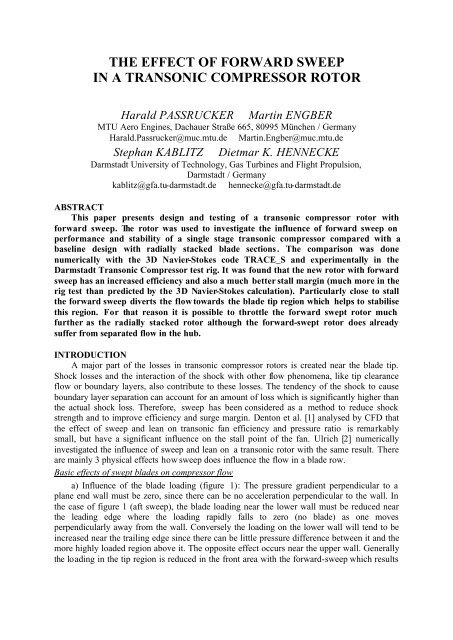


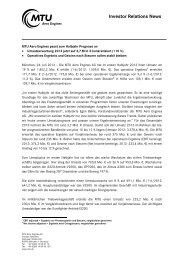
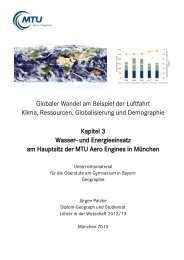
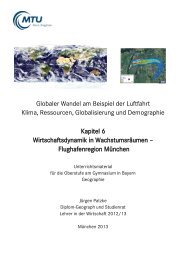
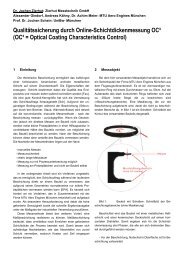
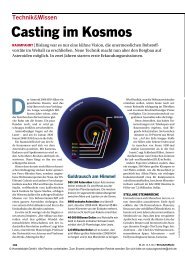

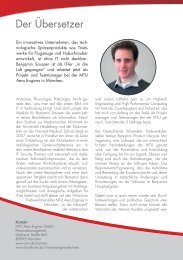
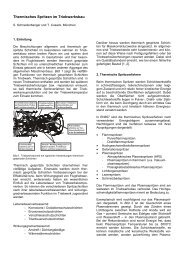
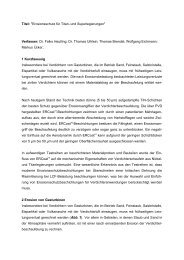


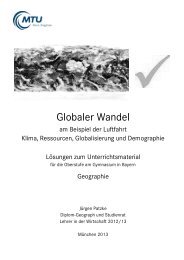
![Download PDF [5,37 MB] - MTU Aero Engines](https://img.yumpu.com/21945461/1/190x125/download-pdf-537-mb-mtu-aero-engines.jpg?quality=85)